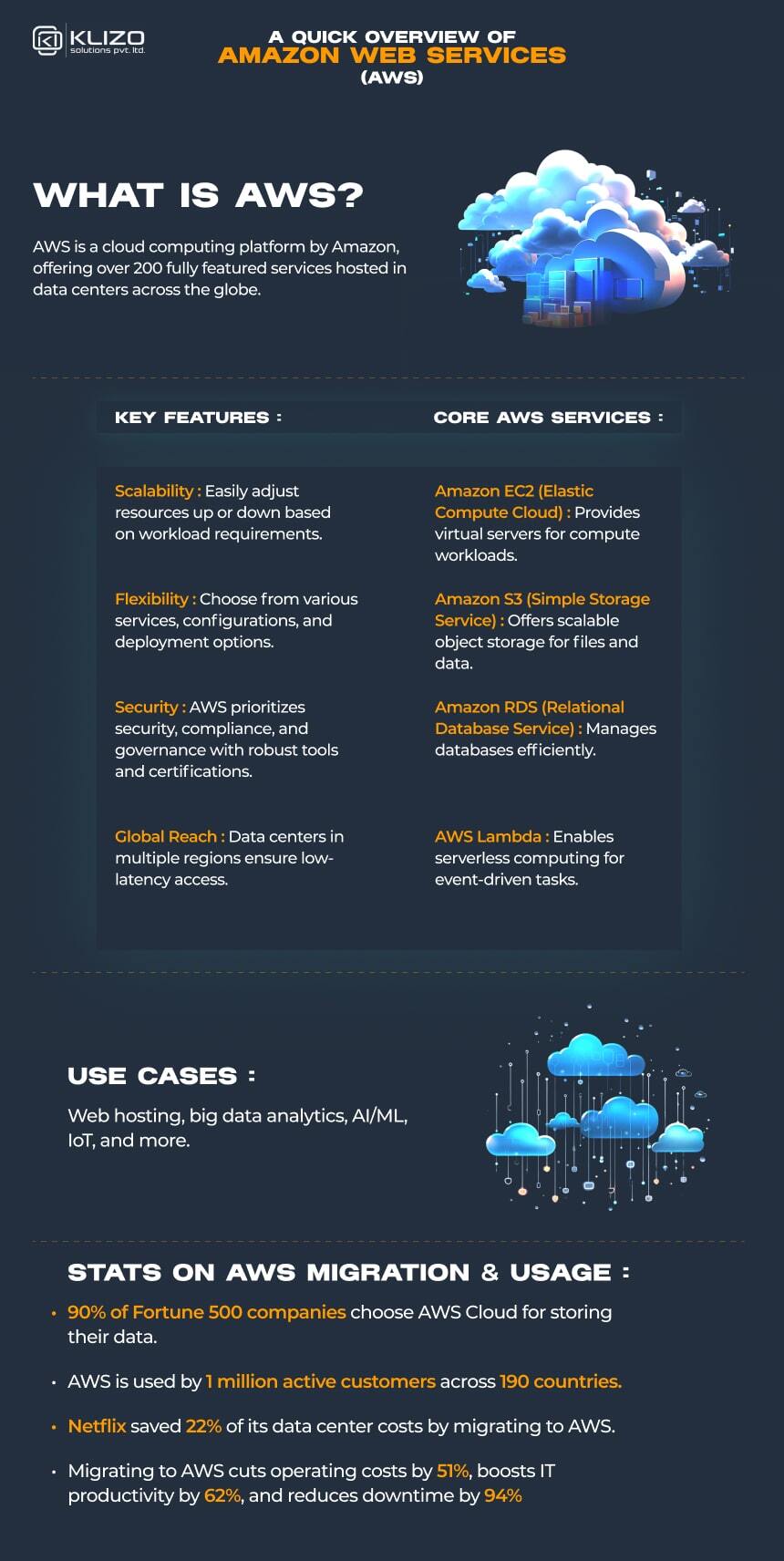


Ever wondered what it takes to migrate your entire IT infrastructure to the cloud?
Picture this: You’re managing a bustling data center, constantly dealing with hardware issues and scaling challenges. Now, imagine offloading all that stress to a robust, reliable cloud service that handles everything for you. Sounds intriguing, right?
Well, that’s the magic of migrating to AWS!
Migrating to AWS is not just a trend; it’s a strategic move many successful companies are making to stay ahead in the competitive landscape.
Take Netflix, for example—they transitioned to AWS and revolutionized their streaming service with enhanced scalability and performance.
Want to learn how you can achieve similar success Let’s dive into your ultimate step-by-step AWS migration guide, where we break down the entire process of AWS Migration into simple, actionable steps.
At its core, AWS or Amazon Web Services is a cloud computing platform—a vast expanse of virtual landscapes that transcends physical boundaries.
Imagine it as a cosmic bazaar where you can shop for computing power, storage, databases, machine learning, and more—all without the hassle of managing physical servers.
AWS isn’t just a service; it’s an entire galaxy of interconnected stars, each representing a different capability.

Launched in 2006, AWS provides a broad range of cloud services, including computing power, storage options, and networking capabilities, on a pay-as-you-go basis and is a widely adopted cloud computing platform.
Migrating to AWS involves several critical steps to ensure a smooth transition from on-premises or other cloud environments to Amazon Web Services. Each step is crucial for minimizing downtime, maintaining data integrity, and achieving a successful migration.
Wondering how to migrate applications to AWS? Here’s a quick breakdown of the key steps or AWS migration best practices:
Plotting the course is the foundational step in migrating to AWS, setting the stage for a smooth transition. This involves thoroughly assessing the current IT environment, identifying applications, databases, and infrastructure components, and understanding their dependencies to ensure a cohesive strategy. Here’s how it works:
By carefully plotting the course, you can mitigate risks, align the migration with your objectives, and streamline the overall process for a successful migration to AWS.
The second phase of cloud migration, Implementation of Change, involves updating the application and making necessary architectural and design modifications.
This phase can be lengthy as it often includes numerous design and re-platforming sessions at a granular level until the application reaches its desired state. During this phase, several types of changes are implemented, including:
This comprehensive process ensures the application is fully optimized for its new environment, taking full advantage of the cloud’s scalability, performance, and cost-efficiency. Remember, this phase of migrating to AWS isn’t just about code—it’s about cosmic craftsmanship. We’re building a starship that’ll sail through the cloud cosmos.
After completing the implementation phase, the next critical step is Data Migration, which involves transferring essential static files, dependencies, and database tables to AWS services. Here is how it works:
Data Migration is a meticulous process requiring careful planning and execution. With proper AWS migration tools and services, businesses can successfully transition to AWS, leveraging its benefits of improved performance and scalability. Remember, a well-planned data migration ensures a seamless transition to the cloud environment.
In this crucial phase of migrating to AWS, the focus shifts to the actual migration of your application onto Amazon Web Services (AWS) infrastructure. This step ensures seamless integration and optimal performance on AWS’s robust cloud platform. Here’s a detailed breakdown of what this AWS migration step entails:
Example Scenario:
Imagine migrating a high-traffic e-commerce platform to AWS. By deploying application components on EC2 instances with load balancers and leveraging auto-scaling capabilities, the platform achieves seamless scalability during peak shopping seasons. Containerized microservices are managed effortlessly using AWS Fargate, ensuring efficient resource allocation and deployment flexibility.

Once your applications are migrated to AWS, the next critical step for migrating to AWS is to validate their functionality and ensure seamless operation in the cloud environment.
This phase of migrating to AWS involves rigorous testing and operational checks to guarantee optimal performance and reliability. Here’s a detailed outline of what this step entails:
Example Scenario: Imagine moving a busy online store to AWS. By using EC2 for computing and load balancers for traffic, the store can handle big shopping days easily. They also use AWS Fargate for their containerized services, making it simple to manage and adjust as needed.
Migrating to AWS is a game-changer for businesses aiming to boost efficiency, scalability, and innovation.
Whether you’re moving from an on-premises setup or simplifying your current cloud operations, our step-by-step AWS migration guide provides the roadmap you need for a smooth migration journey.
At Klizo Solutions, we specialize in making your cloud migration seamless and stress-free. With our expertise in cloud migration and AWS services, we ensure your transition is not only successful but also optimized for your unique business needs.
Are you ready to take the leap to the cloud? Let the expert AWS engineers of Klizo Solutions guide you every step of the way by implementing the AWS migration best practices! Contact us today!
Previous article

Subscribe to our newsletter to get the latest tech updates.